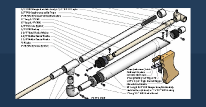Note that this firing test was done before I got the [k26] spring.
Finally got around ordering some [k26] springs from McMaster. I was told that the inconsistent shots I was getting in the video was due to the fact I was running a really weak spring combo, so I'm hoping the [k26] spring will solve that issue. Searched around for some recommendations on what length to cut the spring down to. I found a post on sgnerf that said to start at about 5 inches and work down from there. I tried 5 inches and it was extremely difficult to prime the blaster. It took way too much effort to get the priming handle all the way back, and once I did the trigger plate wouldn't even catch. So I cut down the spring some more and I'm now at about 4 inches. At this length, the blaster is still a little difficult to prime, but it's definitely a lot more manageable and probably a lot more practical during a game.
Unfortunately, I'm still unable to get the trigger plate to catch. If you look below, you'll see a picture of my trigger plate with the two springs on it. I'm using the stock spring plus another which I took from behind a little piece in the longshot stock. Using this spring combo, the trigger plate would catch with no issues when I was using the stock longshot spring and a recon spring inside the plunger (as you can see on the video above). I know it's not an issue of the plunger rod not going back far enough to catch the trigger plate, because I already resolved that issue the first time around. If you look at the first picture below, you can see I added a piece of felt padding to the plunger rod. I even went back to my first spring combo to make sure that the gun could prime, and it did.
Super frustrating -___-; I've put in so much time, effort, and money (
Click to enlarge the pictures.
Plunger rod with padding

This is what the plunger rod looks like with the spacer/padding


Stock spring and spring from the stock

Edited by Limeaway, 08 October 2011 - 02:57 AM.












